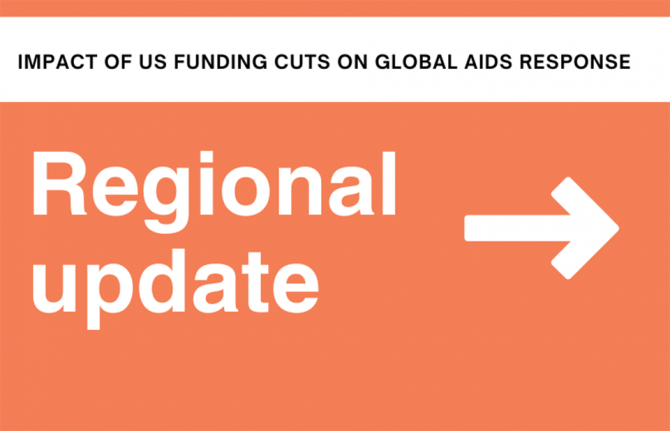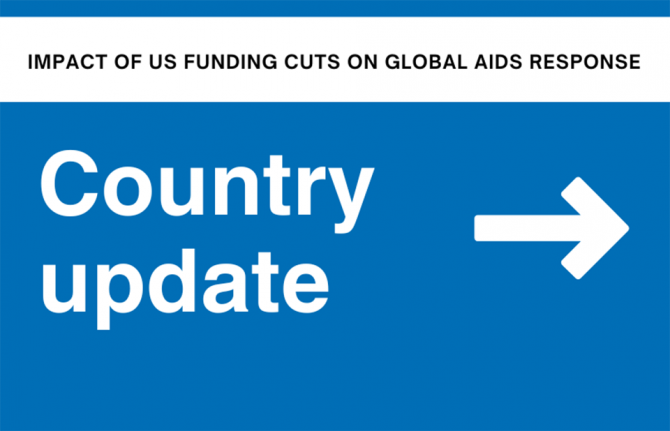
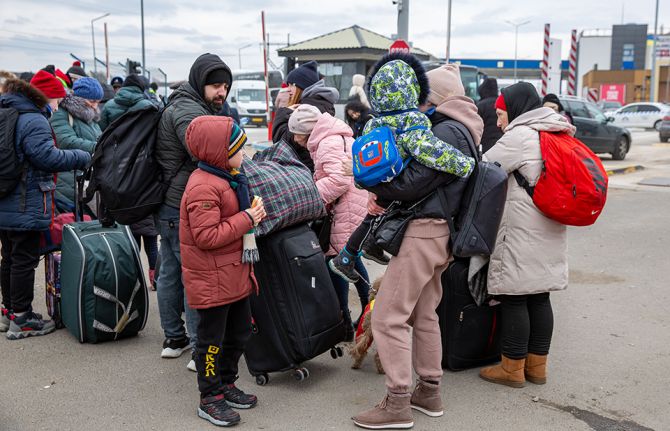
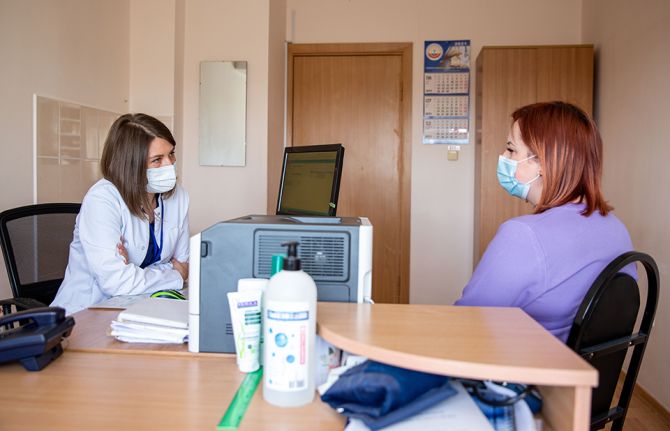
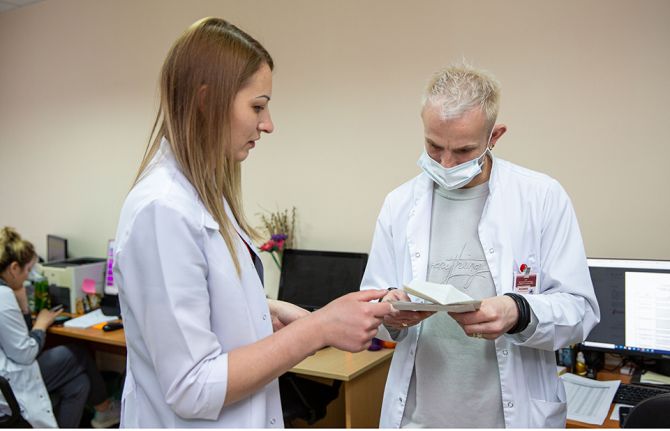
Feature Story
Navigating HIV services during migration crisis in Eastern Europe and Central Asia
17 April 2024
17 April 2024 17 April 2024Countries affected by the migration crisis in Eastern Europe and Central Asia, prompted by the war in Ukraine and other turmoil in the region, have had to put in place measures so that all displaced people have access to essential HIV services.
Key Figures:
- In 2022, Europe was confronted by the largest refugee crisis since World War II.
- As of February 2024, nearly one-third of Ukraine’s population remains displaced, with 6.3 million Ukrainian refugees globally, primarily concentrated in Europe, 62% of them are women.
- In 2022, around one million Russian citizens emigrated, with many choosing prolonged stays abroad.
- Central Asian countries witnessed the biggest influx of international migrants since their independence.
- Up to 300,000 Belarusians left their country since May 2020.
- Migration from Central Asia to Russia surged in 2023, with notable increases in Uzbek, Kyrgyz, and Tajik nationals entering for work purposes. (ICMPD Migration Outlook Eastern Europe and Central Asia 2024)
- The HIV epidemic is growing in Eastern Europe and Central Asia, with Russia, Ukraine, Uzbekistan, and Kazakhstan accounting for 93% of new infections in the region combined.
Surviving the devastating events of March 2022 in Mariupol, Ukraine, uncertain of what the future held, Svetlana fled her hometown.
"Mariupol was a scene of utter destruction. I had a packed suitcase, but I left it behind, only taking with me a dog and a cat," recalls Svetlana. "With assistance, we managed to reach the Polish border, eventually finding refuge in Lithuania."
Living with HIV since 2000, Svetlana relies on anti-retroviral treatment (ARV) to keep the virus at bay by taking a tablet a day. In haste, she had only taken one pill box.
Upon her arrival in Lithuania, she connected with an online organization that within days helped her to obtain her life-saving medicine from a doctor.
Svetlana is one of 70 participants in 6 countries in the Regional Expert Group on Migration and Health (REG) study that assessed the healthcare access for Ukrainian refugees using qualitative methods. According to Daniel Kashnitsky, the lead REG expert, “insights from specialists and service recipients revealed that all HIV-positive refugees had access to treatment across EU host countries.”
After recovering from the initial shock, the European Union activated the Temporary Protection Directive, establishing legal guidelines for managing mass arrivals, offering humanitarian aid, and ensuring access to life-saving antiretroviral treatment and basic HIV services to those in need.
Outside the EU, in countries like Moldova and Georgia, special regulations ensure free access to HIV services. Moldova's National AIDS Coordinator, Yuri Klimaszewski, underscored that Moldova provided HIV services to refugees like it does for its citizens.
The study also revealed that some refugees struggled in host countries, leading to challenges maintaining treatment adherence. Tatyana (name changed) left Odessa along the Black Sea in April 2022.
But she returned home because she could not find adequate support under the opioid maintenance therapy program in Poland. She found it complicated to reach the service point, the language barriers prevented her from communicating her needs with medical staff, and she lacked community support.
“Despite the unprecedented support shown by European countries to Ukrainian refugees, systemic issues, particularly bureaucratic complexities, require proactive intervention by social workers, community organisations and volunteers to effectively address these challenges,” said Mr Kashnitsky. Additionally, he added, “there is a pressing need to tackle the stigma faced by people living with HIV and other key populations, such as people who use drugs.”
Uladzimir, who left Belarus for Poland in the first days of the war in Ukraine, needed about a month to start receiving ARV treatment. First, he had to obtain "international protection", then confirm his HIV status and wait for an appointment with a doctor. But once all that was cleared, he had access to all the necessary services. For many accessing services is not as straightforward as it is for Ukrainian refugees, according to the REG study “Forced migrants with HIV status: social psychological and medical aspects of adaptation”
Legislation in some countries makes accessing HIV prevention and treatment for migrants challenging. And in some cases, national healthcare systems may lack resources to meet the influx of people and their needs.
As the Russian Federation continues to deport migrants living with HIV, those who remain in Russia due to the inability to return home or for family reasons are compelled to stay in the country illegally. They are deprived of HIV treatment and health services. Some have succeeded by receiving treatment remotely (ARVs sent to them with the help of countries of origin).
Recommended strategies, as outlined by the REG study, include improving the system of informing people about potential risks and available HIV services abroad, establishing health insurance protocols, and supporting community organizations that provide HIV services.
Removing legal provisions that discriminate against migrants living with HIV will also reduce barriers to accessing antiretroviral therapy, resulting in significant improvements for public health in the region.
Eamonn Murphy, UNAIDS Regional Director for Asia Pacific and EECA regions, praises the collaborative efforts involving various stakeholders, including governments of countries of origin and host countries, community organizations, the Joint UN Programme on AIDS, and donors.
However, he says more needs to be done. “There is an urgent need to work on the legalization and standardization of such approaches to ensure all people on the move can access essential services and remain on treatment wherever they are.”
Region/country
- Eastern Europe and Central Asia
- Albania
- Armenia
- Azerbaijan
- Belarus
- Bosnia and Herzegovina
- Bulgaria
- Croatia
- Cyprus
- Czechia
- Estonia
- Georgia
- Hungary
- Kazakhstan
- Kyrgyzstan
- Latvia
- Lithuania
- Montenegro
- Poland
- Republic of Moldova
- Romania
- Russian Federation
- Serbia
- Slovakia
- Slovenia
- Tajikistan
- North Macedonia
- Türkiye
- Turkmenistan
- Ukraine
- Uzbekistan

